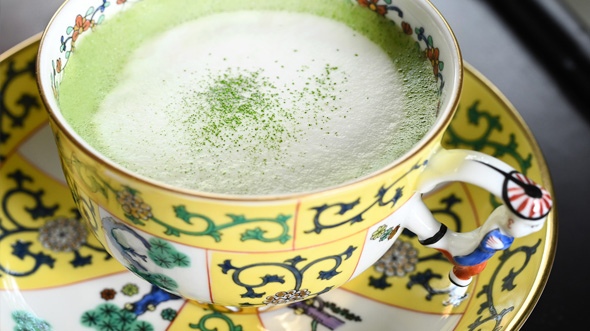Koicha vs. Usucha: Understanding the Differences in Matcha Grades and Preparations
Matcha is a finely ground tea powder made from specially grown and processed green tea leaves. Shaded tea leaves are used, which means that about 30 days before harvest starts the tea bushes are covered to block out direct sunlight, resulting in the uniquely sweet, umami-rich taste and deep green color of the leaves. The harvested leaves are then processed into Tencha, which is then ground in granite mills into the very fine, vibrant green powder we call Matcha.

In the realm of Japanese tea culture, matcha holds a revered place, celebrated for its vibrant green hue, rich flavor, many health benefits, and ceremonial significance. Within this tradition, two distinctive styles of preparing matcha stand out: ⚫ koicha and ⚪ usucha. These two methods offer unique experiences, each with its own texture, taste, and ceremonial context. Whether you're a seasoned tea enthusiast or a curious newcomer, understanding the differences between koicha and usucha enhances your appreciation of this ancient practice.
⚫ Koicha (Thick Tea):
Koicha is made with a higher ratio of matcha powder to water, resulting in a thick, creamy, and intensely flavored tea. The preparation involves gently whisking the matcha with slow, circular motions to avoid froth and achieve a smooth, velvety consistency.
Koicha is made with the highest grade matcha and is reserved for special occasions or formal tea ceremonies. Koicha grade matcha can also be used to make usucha. In fact, after drinking a koicha from a tea bowl, with some extra water added, one can make a nice usucha with the matcha that was left in the bowl.

⚪ Usucha (Thin Tea):
Usucha is prepared with a smaller amount of matcha powder and more water, creating a lighter, frothier tea. The vigorous whisking with a bamboo whisk (chasen) creates an airy froth on the surface of the tea.
Usucha is more commonly enjoyed in everyday settings and has a more accessible, fresh green flavor. Usucha grade matcha is not suitable to make koicha.
Both styles highlight different aspects of matcha's flavor profile and texture, providing unique experiences for tea enthusiasts.

How to make Koicha and Usucha
Tools you will need:
- Bamboo whisk (chasen) - use a chasen with a lower tine count (16-64) to prepare the Koicha and one with a higher tine count (64-120) for whisking Usucha
- Matcha bowl (chawan)
- Bamboo scoop (chashaku)
- Sifter

Koicha:
STEP 1) Warm your matcha bowl by filling it with hot water. Let it sit for a minute, then discard the water and dry the bowl.
STEP 2) Put 4g (2 teaspoon or 4 chashaku scoop) sifted matcha powder into the chawan.
STEP 3) Pour 15 ml (0.5 fl oz) 80℃ (176°F) water over the matcha powder and mix with a chasen until all the lumps are gone.
STEP 4) Pour 15 ml (0.5 fl oz) 80℃ (176°F) water over it again, and whisk slowly and gently until it is a smooth, velvety cream.
STEP 5) When your matcha is ready, drink it immediately, because as it cools down it will get thicker and might turn bitter.
Must try Koicha: Koicha Babamukashi, Matcha Shoukaku, Matcha Ukitsu
Usucha:
STEP 1) Warm your matcha bowl by filling it with hot water. Let it sit for a minute, then discard the water and dry the bowl.
STEP 2) Put 1.5-2g (about 1 teaspoon or 2 chashaku scoop) sifted matcha powder into the chawan.
STEP 3) Pour 75-80 ml (2.7 fl oz) 85℃ (185°F) water over the matcha powder.
STEP 4) Whisk with a chasen (tea whisk) until foamy.
STEP 5) When your matcha is ready, drink it immediately, because as it cools down it might turn bitter and the foam collapses.
Must try Usucha: Matcha Ogurayama, Usucha Biwa no Shiro, Matcha Myouju, Matcha Daigyoku
For a more detailed tutorial on how to make Usucha, check out our blog post HERE.
Put together the perfect set for making Matcha
For Koicha
Kuroraku Shǒraku Jǒ > $209.00, Chasen Chūaraho Kubo Tetsuzo > $41.80, Susutake Chashaku Tokujǒ > $44.00, Stainless Steel Matcha Sifter > $44.55




For Usucha
Irabo Chawan > $58.30, Chasen Kazuho > $27.50, Shirotake Chashaku > $22.00, Tea Strainer Single > $4.40




Both koicha and usucha celebrate the versatility and beauty of matcha, each offering a unique sensory experience. Whether you prefer the rich indulgence of koicha or the refreshing lightness of usucha, exploring these two styles deepens your appreciation for the art and tradition of Japanese tea.




